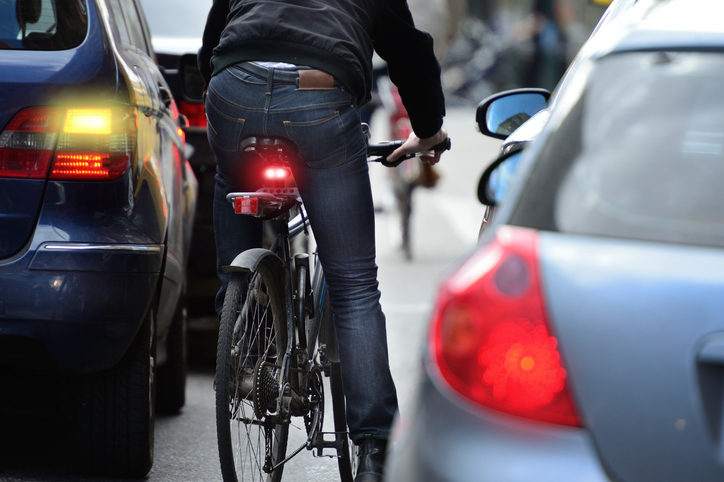How to cycle safely in the city

This article will help you stay safe while cycling in our towns and cities. It will help you cope with all that is going on around you, and it will help give you the confidence to become a safe, careful urban cyclist.
First let’s consider how to plan your urban journeys. They won’t be the same route you’d chose to drive. You should avoid busy roads with lots of motor traffic as much as possible, and use cycle-specific roads and lanes whenever you can.
ROUTE PLANNING
Cycle route-planner websites are a big help. Cycling UK’s Journey Planner (https://www.cyclinguk.org/journeyplanner#) is great. You just put in the postcode of your departure point and the postcode of your destination, then choose either ‘balanced’ or ‘quietest’ as your route mode to avoid the busiest streets. The planner then plots a route comprised of quieter roads, many of which are part of the National Cycle Network (NCN), which uses quiet roads and cycle-specific trails. ‘Balanced’ mode is probably best for commuting, because ‘quietest’ tends to be a bit longer. There are other websites and GPS devices where you can specify what kind of route you want to take.
There are lots of local authorities creating cycle networks in our towns and cities. Many already exist, and the cycle lanes and cycle-ways are the best to choose for your urban cycling journeys. Many of them are well signposted, and local authorities or various bodies also produce maps and websites with details.
A smartphone is very useful for cycle commuting because you can download route-finding apps to it and mount the smartphone on your handlebars. The Bike Hub Cycle Journey Planner is a good example. It’s the route-finding engine of CycleStreets, which allows you to choose between ‘fastest’, ‘quietest’ and ‘balanced’ cycling-route options. As well as a visual display, the app gives turn-by-turn verbal instructions, and unlike more general route-planning apps such as Google Maps, it is cycling-specific. The app favours the quietest roads, backstreets and cycle-ways. It works on iPhone and Android and contains loads of useful information, including the whereabouts of bike shops on your route. Hills are another consideration. Some route planners allow you to specify an ‘avoid hills’ option when planning a route.
Then there’s old-school planning: word of mouth or maps. The sport of cycling’s governing body in the UK, British Cycling (BC), has created a ‘Commute Smart’ series of short videos, which are very useful because they answer common commuter questions and provide handy advice for staying safe on two wheels. One set of advice concerns planning a commuter route, and as well as things I’ve covered above they suggest ‘ask a cyclist’, which is a brilliantly simple but great idea.
JOINING TRAFFIC
OK, good route planning can help avoid cycling with lots of traffic, but there are few towns and cities in the UK at the moment where you can cycle without being close to some motorised transport. In many places you will encounter lots of motor traffic, but don’t let it put you off cycling. There are many things you can do to improve your own safety on the roads.
First, let’s consider riding along a straight street, maybe with multiple lanes and with other road users occupying them. Where do you ride? What position do you take up on the road? Your default road position, if you like.
Generally, keep over to the left of the road about half a metre out from the kerb, further out if there are parked cars. If the traffic flow is slow then ride further out still. This keeps you in the traffic flow, which prevents motorists from overtaking and squeezing you to the side of the road. You need to give yourself room to play with if a pedestrian steps into the road without looking, or somebody opens the driver’s door of a parked vehicle. You aren’t being inconsiderate riding in front of a motorist in this situation. They will still be able to pass you when conditions allow, and all vehicles travelling behind will have a better chance of seeing you.
MANOEUVRING IN TRAFFIC
You will need to make left and right turns in traffic, and sometimes change the lane you are riding in, all of which involve you safely manoeuvring your bike in a way that other road users understand what you are doing. Doing this in traffic requires good observation skills and bike control, as well as clear signalling to other vehicles of your intentions for every manoeuvre. Correct gear selection is also important, as are skills such as getting your feet quickly on to your pedals when setting off, riding slowly without wobbling from side to side, and steering your bike with only one hand on the handlebars.
Be confident and show you are confident. Clear hand signals help do that. Use hand signals before you manoeuvre your bike, including when you are setting off from the side of the pavement and into traffic, when you change lanes and when you turn left or right. Always check behind you before making hand signals to ensure it’s safe to make the manoeuvre.
Once you have made sure it’s safe, indicating the direction you wish to go or turn with a hand signal makes your intentions clear to traffic behind you. But then it’s important to check again to see that those around you have registered what you are doing. Do it quickly, in front and behind you. With practice, you get to tell if another road user hasn’t seen you. Eye contact is crucial: try to establish eye contact with those around you.
You will have to make frequent stops and starts when riding in traffic. You need to be able to remove your feet from the pedals quickly so that you can support yourself and your bike while you wait to move on. Don’t let that put you off fitting clip-in pedals. The clip-in shoe/pedal systems designed for off -road use, as recommended earlier in the book, detach from and clip into pedals very easily. The shoe soles don’t slip when in contact with the road surface either.
If you have to overtake a motor vehicle, do so on the vehicle driver’s side. Never undertake between a vehicle and the kerb. One of the biggest causes of accidents is a car passenger opening their doors into a cyclist.
Select a low gear before you stop to help you to accelerate away in a straight line when you get going again. Make sure you can support yourself with one foot on the ground while stationary. When the road ahead is clear, glance over your shoulder, and if it is safe to do so, move off.
THINGS NOT TO DO IN TRAFFIC
- Never do what cyclists call track-stands, which are only really possible on fixie bikes anyway. Cyclists doing track-stands balance on their bikes with their feet still on the pedals, but no matter how good somebody is at doing this, it’s not a safe practice in traffic. Just the slightest contact from another vehicle is enough to make them lose balance and fall.
- Never hold on to other vehicles while waiting.
- If traffic is stationary, do not weave in and out of it to avoid stopping; just ride slowly and, if you have to stop, put one or both feet down and wait.
TURNING LEFT
Get into position and follow these steps. If you have to change lanes then follow steps 1 and 2 to make that manoeuvre before turning left.
Step 1. Check behind you to see what the traffic conditions are like. If you have to change lanes before turning left, do so well before the left turn you want to make.
Step 2. Wait until there is enough space for you to move into the lane on your left. When it’s safe to change lanes make a left hand signal, and check behind again before you move left.
Step 3. When you are in the furthest left lane, position yourself at least half a metre out from the left kerb, as normal. As you get closer to the left turn, indicate your intentions with a left hand signal. Check behind, and if it’s safe to do so move a little further out from the left kerb to prevent any motor vehicle overtaking from behind while you make your left turn.
Step 4. Turn left. Moving out in the road slightly in the road before you turn means you will be in the correct position on the road you turn into, which is half a metre out from the left kerb. Continue on.
TURNING RIGHT
When turning right on a two-way street in the UK you are turning across the flow of oncoming traffic, so it is a little more complicated than turning left. Follow these steps to turn right safely.
Step 1. You start a right turn from the right-hand side of the left carriageway, or the right-hand side of the furthest right lane of a multi-lane street. So you need to make that manoeuvre first.
Step 2. Check behind you. If it is safe to do so, signal right. Keep your hand signal in place and check behind again, then if it is safe to do so move to the right-hand side of the carriageway, or the right-hand side of the furthest right lane. On some multi-lane roads you might have to make this manoeuvre more than once, so do it as described each time.
Step 3. Take up your new position, and as you approach the right turn check behind you again so you know what is happening. Signal right for the turn.
Step 4. Once at the turn you may have to stop before turning right to let oncoming traffic – or traffic coming out of the road you want to turn into – clear.
Step 5. When the traffic is clear, do the right-turn signal again, check behind and if it’s safe to do so make your right turn, aiming your bike for the slot you will ride in half a metre out from the kerb on the street you are turning into.
Step 6. You should now be riding in a safe position on the road you have turned into.
This is an urban and commuting cyclist's handbook, both inspirational and practical, showing us how to live safer, more enjoyable and healthier lives, both physically and mentally, while reducing our impact on the planet.
Author of numerous bestselling bike books, Chris Sidwells, begins with a brief introduction which shows how cycling is already forming a crucial part of future urban transport, good for the environment as well as our health. Current urban transport models, heavily dependent as they are on cars, are unsustainable both in terms of our health and the environment.
Cycling offers the perfect mass transport, health and wellbeing solution. As well as being an easy way to improve the fitness of the whole family, with some simple know-how, which Chris shares in this book, it can be perfectly safe even in busy cities. Increasingly, local authorities are seeing the essential role that cycling has to play in transport infrastructure; Chris looks at the many different schemes, both financial and infrastructural, to encourage people onto bikes. Commuting by bike also offers a financial benefit to individuals and societies.
Chris shows how to get the right bike for you for commuting and urban cycling, whether that's an electric-assisted bike or pedal-powered only, and how to adjust it properly for your unique build.
He looks at cycling clothing and accessories, including helmets, masks, locks and safety equipment. Chris explains how to keep cycling safely despite inclement weather and the different ways to transport what you need to and from work.
A chapter on bike care and maintenance shows how to carry out basic repair jobs like adjusting gears, mending punctures and adjusting brakes.
Chris explains cycling skills to give you confidence when cycling, including bike control, braking and how to make the most of your gears. He shows when and how to use the extra power provided by an electric bike and offers encouragement to new and returning cyclists.
An extended chapter covers road safety, perhaps the biggest barrier to people commuting by bike. Chris shows how to co-exist safely with other road users and the potential hazards that every cyclist should be aware of. He explains the rules that every cyclist must follow and gives step-by-step guidance on how to carry out manoeuvres on the road.
Chris shows how to choose the best route to and from work. He gives details of the various schemes to encourage commuting by bike, including insurance and where to find information.
Cycling is regarded by many as the best way to regain and maintain fitness. As well as improving both physical and mental wellbeing, cycling can boost our immune system. Cycling also gives self-sufficiency and enhances self esteem.








